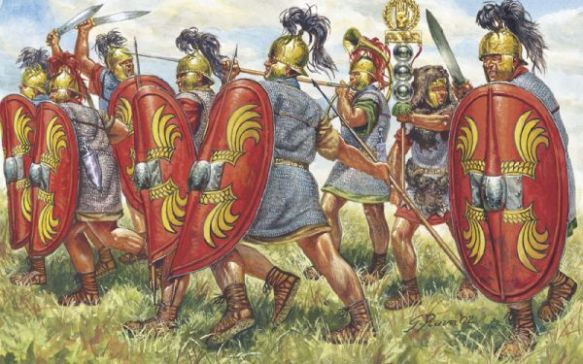Roman legionaries of the late Republic.
Roman sources are uninformative about details of legionary training during the Roman Republic, in large part because they and their audience took the topic for granted. A key problem with trying to reassemble training regimes for the Republic is that the most detailed source that survives dates from four centuries after the Republic. There are a number of features, however, that we can piece together.
Polybius, our best source for the second-century army, suggests that the best training focused on weapons training, care of weapons and armor, and maneuvers by both small and large units. He does not suggest how the Roman military accomplished this regime. On enlistment, a new recruit was called a tiro and was assigned to his unit. Socialization into the society of the legion and expectations began immediately, as did introduction to discipline through routine duties and training.
Soldiers were expected to be fit and to continue exercising during service. Gymnasium exercises and dance both served to develop fitness and flexibility. Soldiers learned to march with their gear. Scipio Africanus introduced (or reintroduced) a four-day training regime that included requiring men to run 4 miles while carrying all their gear on the first day in addition to the regular duties and then to rest completely on the third day. Carrying heavy packs was something that seems to have fallen out of use occasionally, because Marius reintroduced it a century later. He required his men to march 20 miles with full gear and their rations (60 pounds) within a set time or 24 miles with gear and rations at a quicker pace. Caesar similarly expected his men to march fast with full packs and trained them accordingly.
Africanus required his men to make a close inspection of their weapons and rubdown and clean them on the second day of his regime and to mock fight with wooden swords and spears on the fourth day. Marius introduced in his military reforms methods from gladiator training, such as use of a wooden sparring post with which men practiced shield use and stabbing out from behind the shield while instructors shouted. We know from Caesar that the instructors would accustom the men to judging killing distance by shouting out distances, especially the distance at which their enemy’s weapons were effective. The training sword was wooden with a button on the end, and the sword and the shield may have been heavier than normal to build muscle strength and encourage freedom of movement in battle. Soldiers also learned how to throw the javelins and pila by throwing against a wooden pole under orders.
As we learn from Scipio and Marius, recruits and veterans would also practice live combat with weapons covered but in pairs, small units, and larger units. Drill was a regular duty for soldiers in camp. They also practiced maneuvering in groups and following orders. Some commanders also had their troops practice siege skills such as working a battering ram and entrenching and building fortifications. When Aemilianus took command in 134, he found the soldiers unprepared and so required them to build full fortifications, including ditches, and dismantle them daily. Civil engineering projects also served to inculcate discipline, obedience, and teamwork. Legions typically built roads and bridges but sometimes took on larger works. When Marius was preparing his legions for the campaigns against the Cimbri and Teutones, he had them build a canal.
Naval units also required extensive training. The kinds of tactics employed in trireme combat required skilled and disciplined crews to be effective. These strengths contributed to Roman success at sea. When the Romans built fleets, they had to train allies as well as Roman citizens and freed slaves, perhaps requiring non-Latin speakers to learn Latin commands. They had to train extensively to work together, but their naval successes were few until they became more experienced. When Octavian was fighting naval campaigns in 38-36, he was unable to make much headway until Agrippa arranged a closed lake for safe training of single and multiple vessels. In addition to training in weapon use and maintenance and staying fit, soldiers stationed aboard had to practice fighting on moving vessels.
All of the training and unit tasks contributed to internalizing discipline and obedience among the men. The tasks also brought them into the culture of the legions and the fleet and gave the men a shared identity that would help bond them in combat.
References Davies, R. W. “Joining the Roman Army.” In Service in the Roman Army, edited by D. Breeze and V. Maxfield, 3-32. New York: Columbia University Press, 1989. Goldsworthy, A. K. The Roman Army at War, 100 B. C.-A. D. 200. Oxford, UK: Clarendon, 1996. Keppie, L. J. F. The Making of the Roman Army: From Republic to Empire. Updated ed. Norman: University of Oklahoma Press, 1998.
